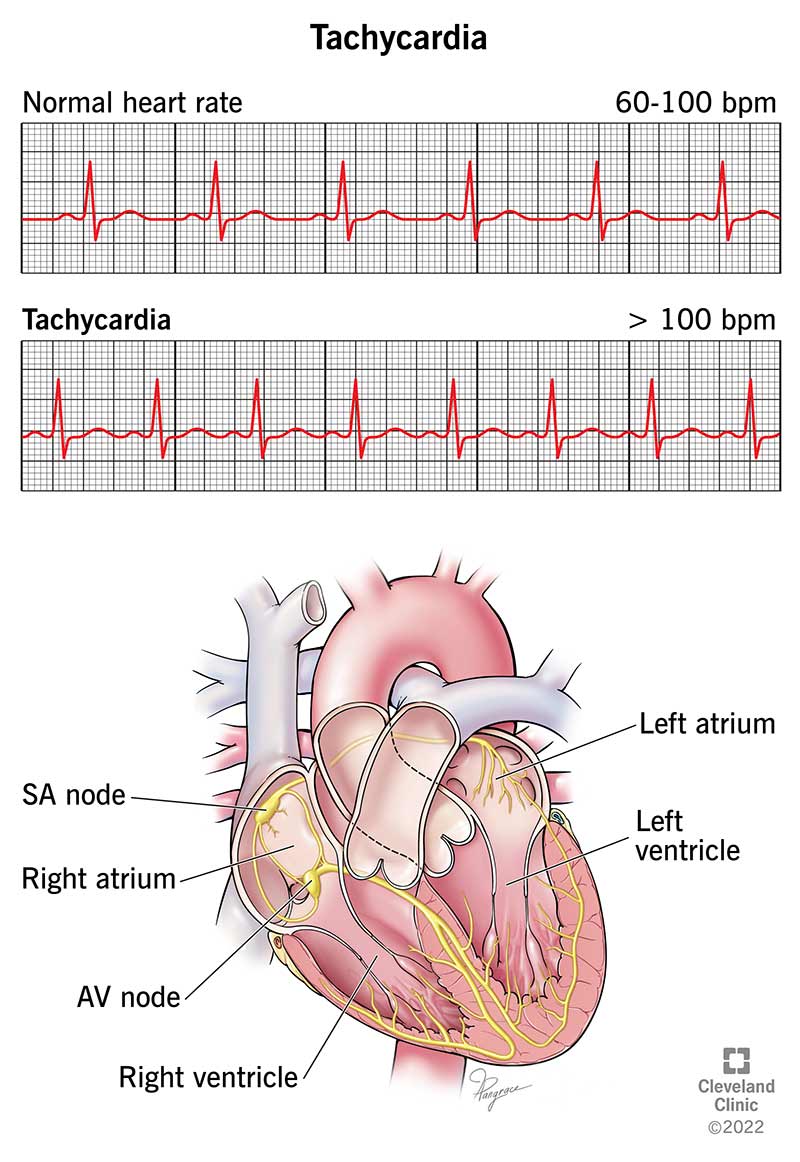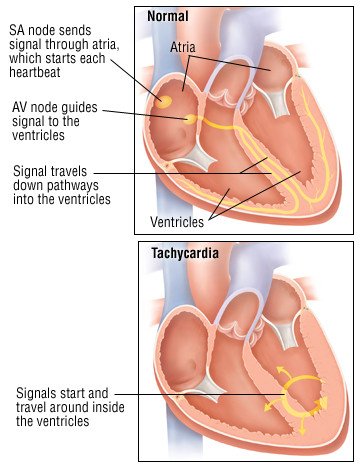Tachycardia Can Best Be Described as
Bundle branch block Wolf-Parkinson-White syndrome. The layer of the heart that is damaged during a heart attack is the _____.

What Is Ventricular Tachycardia Types Symptoms Treatment
Prior to this point the tachycardia can usually be managed by attending physicians or by family physicians through medication changes.

. Tachycardia or rapid heartbeat blood may not be pumped adequately resulting in decreased function or failure of various organs especially the brain and heart muscle Low blood pressure hypotension Thromboembolism Stroke Cardiomyopathy Chronic atrial fibrillation How long does atrial flutter last. More specifically the pain can best be described as a tightness on the left side of my chest and seemingly at times emanating from underneath my left armpit but often on or under the left chest muscle itself. After doing alot of reading on symptons it seems to me that I might have Ventricular Tachycardia in its stable form and the pain and.
Tachyarrhythmia is defined as a heart rhythm with a ventricular rate of 100 beatsmin or greater. Generally it can cause dizziness chest sensations and sometimes fainting. This rhythm can best be described as _____.
Tachycardia is a heartbeat described as over 100 beats per minute in a healthy adult and it is often followed by other symptoms due to the way tachycardia affects your body. Tachycardia refers to the arrhythmical beating of the heart which can be caused by a wide variety of conditions and situations. Tachycardia often causes a considerable amount of fear because when it feels like it is occurring randomly it can make you think that something is wrong with your heart.
It is important to know what is causing your tachycardia because in severe situations it can cause cardiac arrest. NCT reflects rapid activation via the normal His-Purkinje system and therefore tachycardia origin above or. Abnormality of the sinuatrial node or an alteration of the conduction of the same eg.
Tachycardia and hypertension have been shown to be independently associated with a poor outcome after prolonged procedures. Of course rapid heart rate can be associatedSinus tachycardia is when your body sends out electrical signals to make your heart beat faster. Cardiac causes of tachyarrhythmias may either be a result of disturbance in the formation of an electrical impulse ie.
Sustained ventricular tachycardia VT is a ventricular rhythm faster than 100 bpm lasting at least 30 seconds or requiring termination earlier due to hemodynamic instability. The heart rate in such cases may be disturbed or remain normal that is sinus. The heart normally beats at a rate of 60 to 100 times per minute and the pulse felt at the wrist neck or elsewhere matches the contractions of the hearts ventricles the hearts two powerful lower chambers.
- sinus block - sinus tachycardia - sinus rhythm - sinus bradycardia. Your patient is in ventricular tachycardia with a heart rate of 124. Sinus tachycardia refers to a faster-than-usual heart rhythm.
Monomorphic VT non-sustained at. Tachycardia is a heart rate of more than 100 beats per minute. Junctional tachycardia Extra abnormal heartbeats that begin in one of the hearts two ventricles and that are premature and disrupt the regular heart rhythm are called premature atrial complexes.
1 Hypotension may degenerate into a cardiac arrest or the patient may be pulseless from the outset. When you experience a fast heart rate you can be diagnosed with tachycardia. Tachycardia is a condition where the hearts rhythm is unusually fast.
Based on the words Latin roots tachycardia essentially means fast or swift heart. Tachycardia usually refers to any heart rhythm over 120 beats per minute but emergency treatments are usually considered when the heart rate gets to 150 beats per minute or more. It may be sustained or nonsustained.
2 The scope of the problem is large when these situations are considered collectively. Cardiac causes of tachycardia. Tachycardia can be part of the bodys normal response to anxiety fever rapid blood loss or.
Other identified origins are the atrial free wall right more common than. Atrial Tachycardia Diagnosis Definition. Focal atrial tachycardia focal AT is fast and usually regular discharging from a discrete focus of origin.
From a medical perspective this refers to a heart rate. The atrial rate is usually 100-250 beats per minute bpm. His blood pressure is stable but hes complaining of mild dizziness.
Ventricular tachycardia should be described by type monomorphic or polymorphic duration sustained or non-sustained and heart rate ie. Tachyarrhythmias are broadly categorized as narrow complex tachycardia NCT. The origin of focal AT is most commonly from the right atrium.
Tachycardia should be understood as the accelerated work of the heart which determines more than the upper threshold of the age norm in adults it is more than 100 beats per minute. Your heart has a natural pacemaker called the sinus node which generates electrical impulses that move through your heart muscle and. Atrial rhythm 100bpm initiated from a discrete origin Ventricular rate varies depending on AV nodal conduction Can be paroxysmal sustained or incessant ECG Features The key is to find the P-waves.

Tachycardia Causes Symptoms And Treatment

What Is Supraventricular Tachycardia Svt Svt Heart Svt Heart Condition Nursing Notes

Comments
Post a Comment